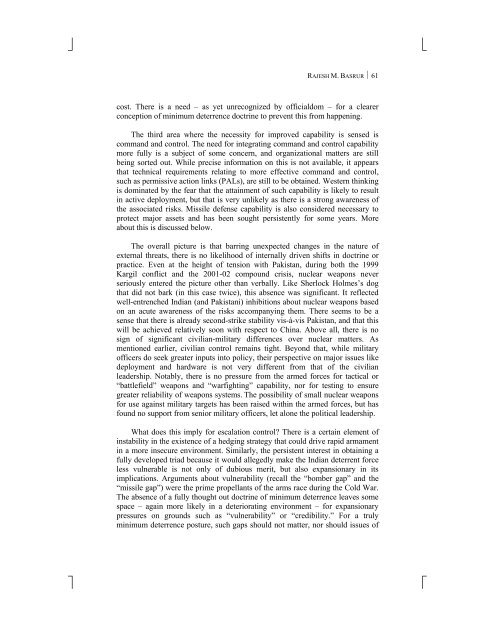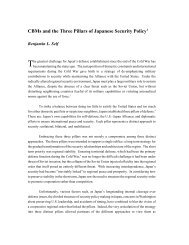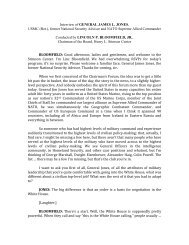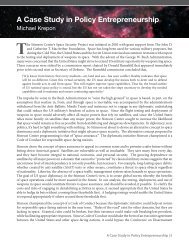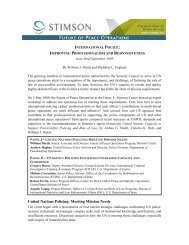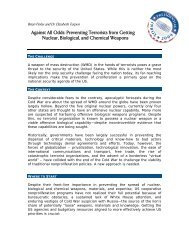India's Escalation-Resistant Nuclear Posture - The Stimson Center
India's Escalation-Resistant Nuclear Posture - The Stimson Center
India's Escalation-Resistant Nuclear Posture - The Stimson Center
Create successful ePaper yourself
Turn your PDF publications into a flip-book with our unique Google optimized e-Paper software.
⎦<br />
⎣<br />
RAJESH M. BASRUR ⏐ 61<br />
cost. <strong>The</strong>re is a need – as yet unrecognized by officialdom – for a clearer<br />
conception of minimum deterrence doctrine to prevent this from happening.<br />
<strong>The</strong> third area where the necessity for improved capability is sensed is<br />
command and control. <strong>The</strong> need for integrating command and control capability<br />
more fully is a subject of some concern, and organizational matters are still<br />
being sorted out. While precise information on this is not available, it appears<br />
that technical requirements relating to more effective command and control,<br />
such as permissive action links (PALs), are still to be obtained. Western thinking<br />
is dominated by the fear that the attainment of such capability is likely to result<br />
in active deployment, but that is very unlikely as there is a strong awareness of<br />
the associated risks. Missile defense capability is also considered necessary to<br />
protect major assets and has been sought persistently for some years. More<br />
about this is discussed below.<br />
<strong>The</strong> overall picture is that barring unexpected changes in the nature of<br />
external threats, there is no likelihood of internally driven shifts in doctrine or<br />
practice. Even at the height of tension with Pakistan, during both the 1999<br />
Kargil conflict and the 2001-02 compound crisis, nuclear weapons never<br />
seriously entered the picture other than verbally. Like Sherlock Holmes’s dog<br />
that did not bark (in this case twice), this absence was significant. It reflected<br />
well-entrenched Indian (and Pakistani) inhibitions about nuclear weapons based<br />
on an acute awareness of the risks accompanying them. <strong>The</strong>re seems to be a<br />
sense that there is already second-strike stability vis-à-vis Pakistan, and that this<br />
will be achieved relatively soon with respect to China. Above all, there is no<br />
sign of significant civilian-military differences over nuclear matters. As<br />
mentioned earlier, civilian control remains tight. Beyond that, while military<br />
officers do seek greater inputs into policy, their perspective on major issues like<br />
deployment and hardware is not very different from that of the civilian<br />
leadership. Notably, there is no pressure from the armed forces for tactical or<br />
“battlefield” weapons and “warfighting” capability, nor for testing to ensure<br />
greater reliability of weapons systems. <strong>The</strong> possibility of small nuclear weapons<br />
for use against military targets has been raised within the armed forces, but has<br />
found no support from senior military officers, let alone the political leadership.<br />
What does this imply for escalation control? <strong>The</strong>re is a certain element of<br />
instability in the existence of a hedging strategy that could drive rapid armament<br />
in a more insecure environment. Similarly, the persistent interest in obtaining a<br />
fully developed triad because it would allegedly make the Indian deterrent force<br />
less vulnerable is not only of dubious merit, but also expansionary in its<br />
implications. Arguments about vulnerability (recall the “bomber gap” and the<br />
“missile gap”) were the prime propellants of the arms race during the Cold War.<br />
<strong>The</strong> absence of a fully thought out doctrine of minimum deterrence leaves some<br />
space – again more likely in a deteriorating environment – for expansionary<br />
pressures on grounds such as “vulnerability” or “credibility.” For a truly<br />
minimum deterrence posture, such gaps should not matter, nor should issues of<br />
⎤<br />
⎡


